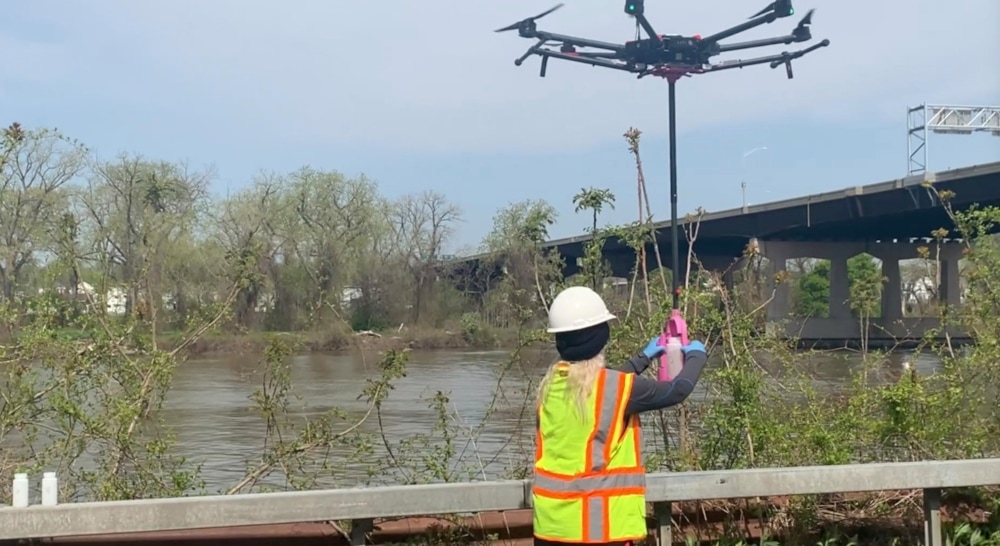How Drones Can Help Improve Our Drinking Water—Nixie System Cuts Cost of Collecting Water Samples by 90%
BY Zacc Dukowitz
30 June 2021A new device called Nixie allows you to collect water samples by drone instead of having to collect them in person.

Photo credit: Reign Maker
Last year, we wrote about Will Reckling, a PhD student at North Carolina State University who had created a device to collect water samples by drone in order to study algal blooms.
But unlike Reckling’s device, Nixie is made for widespread use—and not just by researchers, but also by city and state employees who are working to ensure the safety of our drinking water.
Collecting water samples is a major undertaking. Every year, government employees and contractors take water samples all over the U.S. to test them for contaminants in order to make sure the water is safe to drink.
And collecting those samples is a lot of work. Most people who do it either have to walk to the edge of a body of water to take a sample—while making sure not to stir up sediment and contaminate it—or, more commonly, use a boat.
The New York City Department of Environmental Protection alone collects 14,000 water quality samples a year, collecting 30 samples a day using boats, captains, and a crew of three at an average cost of $100 per sample. With Nixie, a crew of two can collect 120 samples in the same seven-hour shift, at a cost as low as $10 per dip.
– Jessica Chosid, Founder and CEO of Reign Maker
As you can see from the quote above, using a drone with a water sample collection device attached can reduce the cost of collecting samples by 90%.
Improving the cost and efficiency of collecting these samples doesn’t just make the process more inexpensive. It could actually reduce illness due to water contamination by making it easy to increase the amount of samples taken and the frequency with which they’re collected.
How the Nixie System Works
The Nixie water collection device is made by a company called Reign Maker, which uses drones and other robotics solutions to collect and process data for industrial inspection and engineering purposes.
The device’s design is pretty universal, and looks like it could be used on most any big rig drone that can carry an extra 6.6 pounds (that’s the weight of the bottle when it’s full of water).

Picture of the Nixie system
In order to ensure that Nixie would be safe and that it would actually be used, Reign Maker worked with DJI to make the device compatible with both the Matrice 600 and the Matrice 300 RTK.
Here’s how the system works:
- Attach the Nixie device to the drone using an open/close lever mechanism.
- Once attached, you insert one of Nixie’s EPA-approved sample bottles for water collection into a cage in the device.
- Fly to where you want to collect water and lower the device below the surface.
- Fly back, retrieve your sample from the cage, insert a new bottle, and repeat.
The Nixie system can collect water samples two feet below the surface of the water in currents running at speeds of up to five knots. Using this approach, the sample device doesn’t stir up sediment in shallow water, which helps ensure that the samples collected remain free from contamination.
The drone’s flight log can also be used to capture the time and location of each sample, allowing for precise repeat testing over time.
Here are some stats from Reign Maker highlighting the benefits of using the Nixie device over manual approaches for water sample collection:
- 73% time reduction. Reduces time needed to collect a single water sample from 13 minutes to 3.5 minutes.
- 75% increase in sample rates. Allows for 120 samples to be collected in a day as opposed to 30.
- 90% cost reduction. Reduces cost for each sample taken from $100 to $10.
What’s Next for Nixie?
Reign Maker is currently developing an advanced sensor system that will be able to test 21 different water parameters.
The company is also creating a worldwide water database that, once live, will be updated in real time using Nixie data. This database will help support global monitoring of water quality, revealing trends and making it easier to track changes to the purity of water wherever people are using the device to collect water.
But the company’s most important next step probably won’t be related to the things that are currently in development—it will be driving adoption of the Nixie system itself.
If cities start using drones to collect their water samples, not only will they potentially save huge amounts of money by cutting down the cost of sample collection, they’ll also be able to collect more samples.
And, over time, getting more data on the quality of our water could lead to significant improvements in our health, and possibly even save lives. Chalk this up to yet another instance of drones being used for good in the world.


